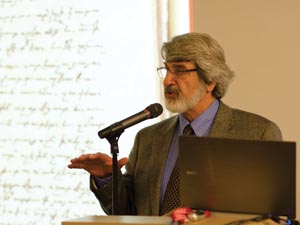Andrew Esguerra
Staff Writer

Photo: Nabil Sakib
As with many cultures that have a language largely unique to their ancestors, the Armenian alphabet and language helped create a unified cultural identity for the Armenian people and is often cited as a definitive factor in the formation of Armenian identity.
Dr. Kevork Bardakjian, Marie Manoogian Professor of Modern Armenian Language and Literature, at the University of Michigan, Ann Arbor, delivered a keynote lecture on “The Impact of the Armenian Script and Printing on Armenian Identity and Letters,” to officially open the Madden Library exhibit “The 500th Anniversary of Armenian Printing.”
Dr. Bardakjian brought his years of experience and research in the field of Armenology to an audience who attended the opening of an exhibit on “The 500 Anniversary of Armenian Printing,” in the Henry Madden Library on Sunday, October 14. He explained through a power-point demonstration the revolution in the Armenian language and literary traditions that began with the creation of the Armenian alphabet by St. Mesrob Mashtots in the fifth century.
Dr. Bardakjian discussed the topic of the invention of the Armenian script, its effect on the Armenians, and how it became so intertwined with Armenian culture. He began his presentation discussing the history of writing in general, with examples of ancient cuneiform inscriptions, such as the one from Behistun, Persia, mentioning the word “Armenian” for the first time in the year 520BC.
Dr. Bardakjian noted that before the invention of the Armenian script, “The Armenian experience had no written record in the Armenian language,” and that only a national memory of Armenian history existed until recorded by Armenian historians of the fifth century. The conversion of Armenia to Christianity was also a reason behind the creation of the alphabet.
The first book translated into Armenian was the Bible. Years of relying on the versions of the sacred texts in languages such as Greek, had created a barrier between the Bible’s message and the Armenian people.
In this way, the Armenian script also contributed to the creation of the new Armenian identity, centered on Christianity and the alphabet.
Dr. Bardakjian also hypothesized that the translation of the Bible to Armenian led to the adaptation of grabar, or Classical Armenian. He stated that Classical Armenian standards were created to meet the flourishes, expressions, wording, and reverence of the Bible that did not appear in the spoken Armenian at the time.
The Armenian alphabet was the root of an explosion of Armenian literature, the creation of collective Armenian identity, and the development of Christianity in Armenia.
“I will never forget the indelible image of a dying Armenian woman during the Genocide writing the Armenian alphabet in the sand to teach it to her son,” concluded Dr. Bardakjian, providing hope for the perseverance of the Armenian language and culture.
Dr. Bardakjian’s presentation established the significance of the discovery of the Armenian alphabet and its immense impact on Armenian cultural history.
 Hye Sharzhoom Armenian Action
Hye Sharzhoom Armenian Action